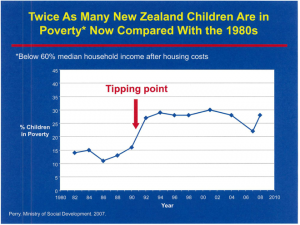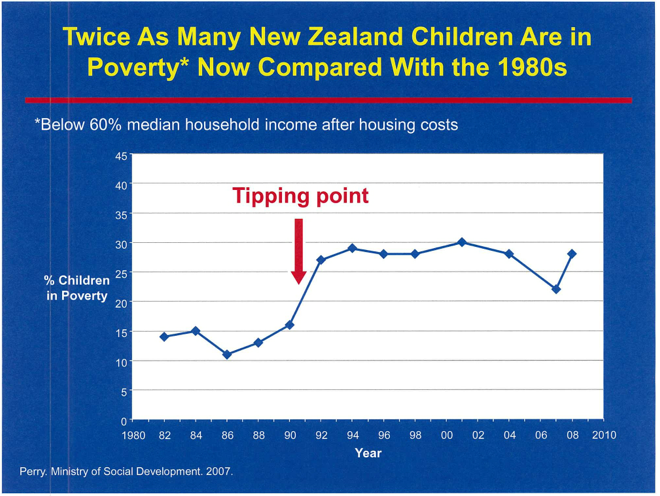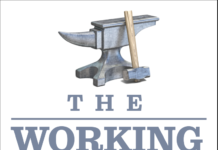There have been a whole raft of reports over the last few weeks detailing the appalling levels of child poverty in New Zealand. An expert advisory group to the Children’s Commissioner has also spelt out the best means to end it.
Yet the government says it is not even measuring child poverty let alone doing anything to end it. Why is that?
Child poverty doubled in the late 1980s and early 1990s and has basically remained at that level since.
 At the time the government imposed economic and social policies that radically increased the levels of unemployment and the number of people forced to live off a benefit – unemployment, sickness, or sole parent. The goal was to break the power of the trade unions and increase competition among working people for the jobs available – thereby forcing down real wages.
At the time the government imposed economic and social policies that radically increased the levels of unemployment and the number of people forced to live off a benefit – unemployment, sickness, or sole parent. The goal was to break the power of the trade unions and increase competition among working people for the jobs available – thereby forcing down real wages.
The “theory” they went by was that once they had succeeded in increasing “competitiveness” of New Zealand capitalism by lowering its costs in relation to other countries then the economy would begin to grow strongly.
As it turned out the economic decline of those years was followed by an even more moderate growth phase from the mid 1990s on so that we actually fell behind the capitalist competitors abroad and NZ capitalism had a declining share of world exports!
Wikipedia sums up the story for us: “Between 1985 and 1992, New Zealand’s economy grew by 4.7% during the same period in which the average OECD nation grew by 28.2%.[21] From 1984–1993 inflation averaged 9% per year, New Zealand’s credit rating dropped twice, and foreign debt quadrupled.[19] Between 1986 and 1993, the unemployment rate rose from 3.6% to 11%.[22]’
What the government was successful at was lowering real wages and increasing the proportion of GDP going to capital compared to labour equivalent to about 10% of GDP – a value of about $20 billion in today’s dollars.
Households made up for the loss in real wages by working more hours (principally by more women and young people) and going into debt.
A report by Simon Collins in the New Zealand Herald 25/11/06 found that average family income in 2001 in constant dollars was the same as in 1981 despite the fact that the proportion of women working went from 47% to 61% and the percentage of families working 50+ hours a week went from half to two thirds.
Household debt also more than doubled as a share of GDP.
What the government has not been successful in doing is radically decreasing the number of people forced onto benefits. That number has remained high because the “recovery” following the deep 1987-1993 recession was so anaemic. Now we are faced with the consequences of the 2008 downturn and the even weaker recovery following.
What has remained constant is to blame people on a benefit for a situation not of their making. In 1992 the then Social Welfare Minister (and subsequent National Prime Minister) Jenny Shipley said “the welfare state…. produces young illiterates, juvenile delinquents, alcoholics, substance abusers, drug addicts and rejected people at an accelerating speed.” John Key has referred to people “who lack the will or desire to work as hard for their living as fellow New Zealanders.”
The truth was that the numbers of working age people receiving a benefit more than doubled as a direct consequence of the 1987-93 recession not because of a mass psychosis suddenly gripping hundreds of thousand of people who chose to stop working.
Blaming beneficiaries for the existence of unemployment under capitalism has been key to the introduction of policies that have pushed their living standards down to the poverty level and thus their children with them.
Benefits as a percentage of the average wage fell significantly after 1985.The single person unemployment benefit dropped from 42 to 30% of the average wage by 1996. National Super for a married couple went from 85% to 72%. A domestic purposes benefit for a parent with one child went from 80% to 53%. The benefit for an unemployed couple with two children went from 95 to 69% of the average wage.
None of these cuts were restored by the 1999-2008 Labour government. But to make matters even worse through Working for Families they institutionalised a system of support for poor families that deliberately excluded beneficiaries. In effect they accepted the notion that people on a benefit were less deserving than those working. Their children could be left to rot in poverty.
The Labour government was implicitly accepting the argument that there needs to be a big gap between the benefit and a job to motivate people to work. There is in fact no evidence for that. Sweden has the highest sole parent benefit in the world yet had the highest percentage of sole parents in work. New Zealand had much lower unemployment when benefits were much higher as a percentage of the average wage.
A first step to tackle child poverty is the restoration of the universal child benefit and the elimination of the discriminatory in work tax credit system – as recommended by the Childrens Commissioner’s expert advisory group. At the end of World War Two New Zealand paid the equivalent of 9% of the average male wage per child in family benefit. In today’s dollars that would be about $100 a week per child.
Can we afford it? Of course we can. They could afford it 1945 when average families were 4 or five. Since then productivity of workers has increased enormously. The only problem is how that wealth is distributed.






The real owners of NZ, the unseen global elites, don’t care who amongst the proles lives or dies., or what their living conditions are.
And the bought-and-paid-for politicians in Wellington don’t care how the proles live or whether they die. Just as long as there is no general discussion.
“They call it reality control. In Newspeak, doublethink.” Orwell, ‘1984’
The politicians must be due for another pay rise by now.
It looks to me like no accident and child poverty is part of the rogernomics master plan still in place today.
Of course the greedy wealthy haven’t worked out that once all the wealth is in their hands there will be a very large group of disaffected poor who have no money to continue to drive the economic growth through the cycle of earning and spending. The more disposable income the workers have the weathier the economy becomes and the stronger it becomes. That is called win-win
All this neo liberal meddling in the trickle down theory only creates an unsubstainable model that will eventually end in tears. It might even take another 50 years or so but the revolution to rebalance misgotten wealth must be inevitable. It was, and still is a blinkered plan.
Any chance Shearer is the great white hope to prevent this tragedy?
Great post Mike Treen.
No Shearer is not the great white hope, he wouldn’t know good working class policy if it hit him in the bum. Remember this is a man who was earning an obscene amount of money working for the UN! Labour left 150,000+ kids in poverty during strong econmic times, nothing has changed. More people need to read the Spirit Level and understand what the gap between the rich and poor and how big it has grown means for our country as a whole.
[…] Child Poverty in New Zealand […]
Well written Mike.
We should all be hanging our heads in shame, a Country is judged on how it treats those less well off, regardles of their circumtances.
The really sad thing is that the negative, shameful and vicious responses posted as comments following several articles, exposes what a vicious, punitive and uncaring society we have now become. Neo-liberalism has done its work well… if you’re not earning money you are nothing and deserved to be punished!!!
Comments are closed.